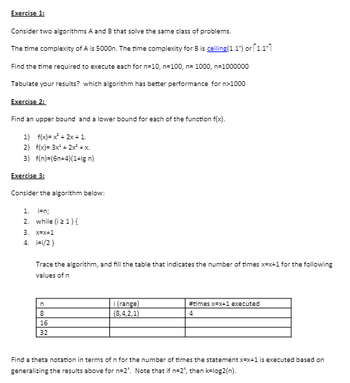
Database System Concepts
7th Edition
ISBN: 9780078022159
Author: Abraham Silberschatz Professor, Henry F. Korth, S. Sudarshan
Publisher: McGraw-Hill Education
expand_more
expand_more
format_list_bulleted
Question
Hello, can you please help me do exercise 3 (with subparts 1,2,3, and 4)?
Thank you so much!

Transcribed Image Text:Exercise 1:
Consider two algorithms A and B that solve the same class of problems.
The time complexity of A is 5000n. The time complexity for B is ceiling(1.1) or 1.17
Find the time required to execute each for n=10, n=100, n= 1000, n=1000000
Tabulate your results? which algorithm has better performance for n>1000
Exercise 2:
Find an upper bound and a lower bound for each of the function f(x).
f(x)=x²+2x+1.
1)
2) f(x)= 3x²+2x² + x
3) f(n)-(6n+4)(1+lg n)
Exercise 3:
Consider the algorithm below:
1. ien;
2. while (i z1) {
3. x=x+1
4. i=i/2}
Trace the algorithm, and fill the table that indicates the number of times x=x+1 for the following
values of n
n
8
16
32
i (range)
(8,4,2,1)
#times x=x+1 executed
4
Find a theta notation in terms of n for the number of times the statement x-x+1 is executed based on
generalizing the results above for n=2". Note that if n=2", then k=log2 (n).
Expert Solution
This question has been solved!
Explore an expertly crafted, step-by-step solution for a thorough understanding of key concepts.
Step by stepSolved in 3 steps

Knowledge Booster
Learn more about
Need a deep-dive on the concept behind this application? Look no further. Learn more about this topic, computer-science and related others by exploring similar questions and additional content below.Similar questions
- Can you please also explain what are the differences between the two algorithms?arrow_forwardIn the algorithmic world, the steps are very similar, but we can use simple loops to dowhat we are doing manually.This would translate to a set of steps as below:Step 1: Open a new spreadsheetStep 2: Create the header row in every worksheetStep 3: For each workbook from a storeFor each worksheet in the workbookRead rows 2 to last row that contains dataMove this row to the current rowAdvance to next rowNext worksheetNext workbookStep 4: Save workbook Write code for given algrithm.arrow_forward“object-oriented programming composition”. Explain the concept of Composition in your own words. Explain it so that you classmates can understand this important OOP concept. Provide examples.arrow_forward
- python 3 Write a program that lists all ways people can line up for a photo (all permutations of a list of strings). The program will read a list of one word names, then use a recursive method to create and output all possible orderings of those names, one ordering per line. When the input is: Julia Lucas Mia then the output is (must match the below ordering): Julia Lucas Mia Julia Mia Lucas Lucas Julia Mia Lucas Mia Julia Mia Julia Lucas Mia Lucas Julia question: is it any way that i can use ('if' statement as base case, and 'else' statement as recursive case) in the code below? thanks. code: def all_permutations(permList, nameList):# TODO: Implement method to create and output all permutations of the list of names.def createPermutationsList(nameList):f = len(nameList) if f == 0:return [] if f == 1:return [nameList] permList = [] for i in range(f):newList = nameList[i]remaining = nameList[:i] + nameList[i+1:]for p in createPermutationsList(remaining):permList.append([newList] + p)…arrow_forwardcreate a new Java application called "Parser"arrow_forwardQuestion 5 Dk .Full explain this question and text typing work only We should answer our question within 2 hours takes more time then we will reduce Rating Dont ignore this linearrow_forward
arrow_back_ios
arrow_forward_ios
Recommended textbooks for you
 Database System ConceptsComputer ScienceISBN:9780078022159Author:Abraham Silberschatz Professor, Henry F. Korth, S. SudarshanPublisher:McGraw-Hill Education
Database System ConceptsComputer ScienceISBN:9780078022159Author:Abraham Silberschatz Professor, Henry F. Korth, S. SudarshanPublisher:McGraw-Hill Education Starting Out with Python (4th Edition)Computer ScienceISBN:9780134444321Author:Tony GaddisPublisher:PEARSON
Starting Out with Python (4th Edition)Computer ScienceISBN:9780134444321Author:Tony GaddisPublisher:PEARSON Digital Fundamentals (11th Edition)Computer ScienceISBN:9780132737968Author:Thomas L. FloydPublisher:PEARSON
Digital Fundamentals (11th Edition)Computer ScienceISBN:9780132737968Author:Thomas L. FloydPublisher:PEARSON C How to Program (8th Edition)Computer ScienceISBN:9780133976892Author:Paul J. Deitel, Harvey DeitelPublisher:PEARSON
C How to Program (8th Edition)Computer ScienceISBN:9780133976892Author:Paul J. Deitel, Harvey DeitelPublisher:PEARSON Database Systems: Design, Implementation, & Manag...Computer ScienceISBN:9781337627900Author:Carlos Coronel, Steven MorrisPublisher:Cengage Learning
Database Systems: Design, Implementation, & Manag...Computer ScienceISBN:9781337627900Author:Carlos Coronel, Steven MorrisPublisher:Cengage Learning Programmable Logic ControllersComputer ScienceISBN:9780073373843Author:Frank D. PetruzellaPublisher:McGraw-Hill Education
Programmable Logic ControllersComputer ScienceISBN:9780073373843Author:Frank D. PetruzellaPublisher:McGraw-Hill Education

Database System Concepts
Computer Science
ISBN:9780078022159
Author:Abraham Silberschatz Professor, Henry F. Korth, S. Sudarshan
Publisher:McGraw-Hill Education

Starting Out with Python (4th Edition)
Computer Science
ISBN:9780134444321
Author:Tony Gaddis
Publisher:PEARSON

Digital Fundamentals (11th Edition)
Computer Science
ISBN:9780132737968
Author:Thomas L. Floyd
Publisher:PEARSON

C How to Program (8th Edition)
Computer Science
ISBN:9780133976892
Author:Paul J. Deitel, Harvey Deitel
Publisher:PEARSON

Database Systems: Design, Implementation, & Manag...
Computer Science
ISBN:9781337627900
Author:Carlos Coronel, Steven Morris
Publisher:Cengage Learning

Programmable Logic Controllers
Computer Science
ISBN:9780073373843
Author:Frank D. Petruzella
Publisher:McGraw-Hill Education